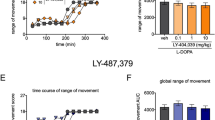Summary
Budipine (1-t-butyl-4,4-diphenylpiperidine) is a novel antiparkinsonian agent. Its clinical efficacy has been proven in double-blind placebo-controlled trials. The mechanism of action of budipine, however, is unknown. Budipine selectively increased the threshold of N-methyl-D-aspartate (NMDA)-induced seizures in mice. Similar to known specific NMDA antagonist, budipine depressed polysynaptic spinal reflexes in mice, but had no consistent effect on spinal monosynaptic reflexes. In receptor binding experiments, budipine displaced thienylcyclohexylpiperidyl-3,4-[3H]-(n) ([3H]-TCP) from its binding site with an IC50 of 36 μM suggesting that budipine acts as a non-competitive NMDA antagonist with moderate receptor affinity. It is concluded that the newly discovered NMDA antagonistic action of budipine is at least partly responsible for its antiparkinsonian activity. Our findings are additional evidence for the hypothesis that NMDA antagonists may be useful in the treatment of Parkinson's disease (PD).
Similar content being viewed by others
References
Carlsson M, Carlsson A (1989) The NMDA antagonist MK-801 causes marked locomotor stimulation in monoamine-depleted mice. J Neural Transm 75: 221–226
Honoré T, Davies SN, Drejer J, Fletcher EJ, Jacobsen P, Lodge D, Nielsen FE (1988) Quinoxalinediones: potent competitive non-NMDA glutamate receptor antagonists. Science 241: 701–703
Iizuka J, Fischer R (1986) Influence of budipine on parkinsonian tremor—a controlled comparison with amantadine. Nervenarzt 57: 184–186
Jellinger K, Bliesath H (1987) Adjuvant treatment of Parkinson's disease with budipine: a double-blind trial versus placebo. J Neurol 234: 280–282
Klockgether T, Turski L (1989) Excitatory amino acids and the basal ganglia: implications for the treatment of Parkinson's disease. Trends Neurosci 12: 285–286
Klockgether T, Turski L (1990) NMDA antagonists potentiate antiparkinsonian actions of L-Dopa in monoamine-depleted rats. Ann Neurol 28: 539–546
Koek W, Woods JH, Winger GD (1988) MK-801, a proposed noncompetitive antagonist of excitatory amino acid neurotransmission, produces phencyclidine-like behavioral effects in pigeons, rats and rhesus monkeys. J Pharmacol Exp Ther 245: 969–974
Löschmann PA, Lange KW, Kunow M, Rettig KJ, Jähnig P, Honoré T, Turski L, Wachtel H, Jenner P, Marsden CD (1991) Synergistic effects of the AMPA-antagonist NBQX and the NMDA-antagonist CPP with L-Dopa in experimental models of Parkinson's disease. J Neural Transm [PD Sect] 3: 203–213
Menge HG, Brand U (1982) Zusammenfassende Darstellung der Pharmakologie von Budipin, einem neuen 4,4-Diphenylpiperidin-Derivat für die Parkinson-Therapie. Drug Res 32: 85–98
Menge HG, Brand U (1985) Pharmacologic bases of antiparkinsonian therapy. In: Gerstenbrand F, Poewe W, Stern G (eds) Clinical experiences with budipine in Parkinson therapy. Springer, Berlin Heidelberg New York Tokyo, pp 82–92
Mihatsch W, Russ H, Przuntek H (1988) Intracerebroventricular administration of 1-methyl-4-phenylpiridinium ion in mice: effects of simultaneously administered nomifensine, deprenyl, and 1-t-butyl-4,4-diphenylpiperidine. J Neural Transm 71: 177–188
Offermeier J, van Rooyen JM (1985) The pharmacodynamics of budipine on central neurotransmitter systems. In: Gerstenbrand F, Poewe W, Stern G (eds) Clinical experiences with budipine in Parkinson therapy. Springer, Berlin Heidelberg New York Tokyo, pp 93–106
Przuntek H, Russ H (1985) Budipine and the MPTP binding site. Lancet ii: 35–36
Przuntek H, Stasch J-P (1985) Biochemical and pharmacological aspects of the mechanism of action of budipine. In: Gerstenbrand F, Poewe W, Stern G (eds) Clinical experiences with budipine in Parkinson therapy. Springer, Beerlin Heidelberg New York Tokyo, pp 107–112
Schmidt WJ, Bubser M (1989) Anticataleptic effects of the N-methyl-D-aspartate antagonist MK-801 in rats. Pharmacol Biochem Behav 32: 621–623
Siegfried J, Fischer R (1985) Budipine: a new chemical substance in the treatment of Parkinson's disease. In: Gerstenbrand F, Poewe W, Stern G (eds) Clinical experiences with budipine in Parkinson therapy. Springer, Berlin Heidelberg New York Tokyo, pp 152–157
Steppuhn KG, Turski L (1991) Modulation of seizure threshold for excitatory amino acids in mice by antiepileptic drugs and chemoconvulsants. Naunyn-Schmiedebergs Arch Pharmacol 345: R68
Turski L, Bressler K, Klockgether T, Stephens DN (1990) Differential effects of the excitatory amino acid antagonists, 6-cyano-7-nitroquinoxaline-2,3-dione (CNQX) and 3((±)-2-carboxypiperazin-4-yl)-propyl-1-phosphonic acid (CPP), on spinal reflex activity in mice. Neurosci Lett 113: 66–71
Turski L, Bressler K, Rettig KJ, Löschmann PA, Wachtel H (1991) Protection of substantia nigra from MPP+ neurotoxicity by N-methyl-D-aspartate antagonists. Nature 349: 414–418
Zech K, Sturm E, Ludwig G (1985) Pharmacokinetics and metabolism of budipine in animals and humans. In: Gerstenbrand F, Poewe W, Stern G (eds) Clinical experiences with budipine in Parkinson therapy. Springer, Berlin Heidelberg New York Tokyo, pp 113–121
Author information
Authors and Affiliations
Rights and permissions
About this article
Cite this article
Klockgether, T., Jacobsen, P., Löschmann, P.A. et al. The antiparkinsonian agent budipine is an N-methyl-D-aspartate antagonist. J Neural Transm Gen Sect 5, 101–106 (1993). https://doi.org/10.1007/BF02251200
Received:
Accepted:
Issue Date:
DOI: https://doi.org/10.1007/BF02251200




